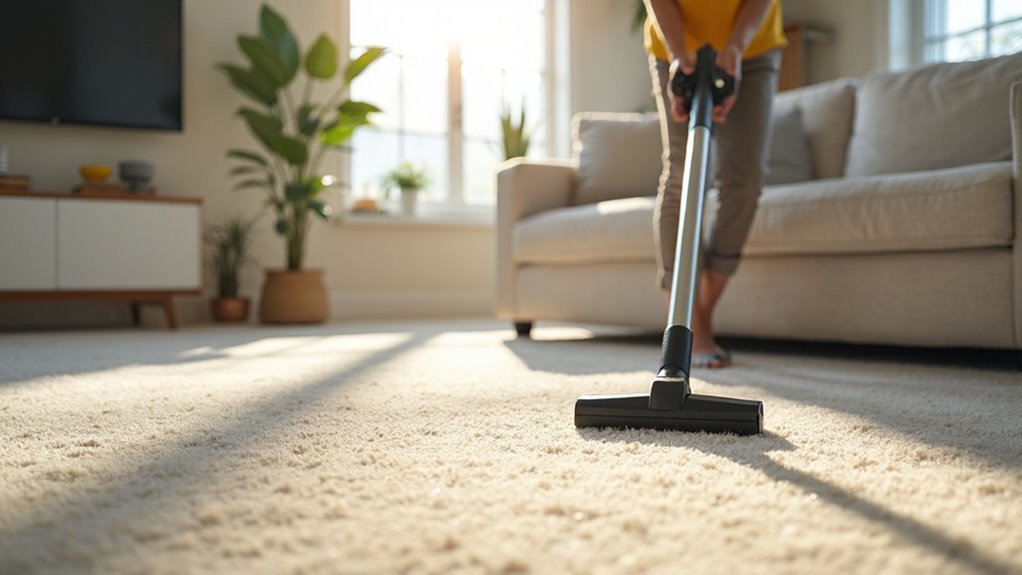Your carpet is more than just a floor covering—it’s an investment in your home’s comfort and style. But without proper care, even the highest-quality carpets can quickly lose their luster and appeal. If you’ve ever wondered how some homeowners maintain carpets that look pristine years after installation, you’re about to uncover the secrets. Professional maintenance isn’t as complicated as you might think, and with a few strategic approaches, you can protect your carpet’s appearance and extend its lifespan.
Understanding Carpet Fiber Types and Their Unique Care Requirements
While many homeowners overlook the importance of fiber knowledge, understanding your carpet’s material is essential for proper maintenance.
Different fibers require specific cleaning techniques and care strategies. Wool carpets, for instance, need gentle treatments and professional cleaning to prevent damage, while synthetic fibers like nylon and polyester can withstand more rigorous cleaning methods.
When determining your carpet’s care routine, identify its fiber type first. Synthetic carpets typically resist stains better and can handle stronger cleaning solutions.
Natural fiber carpets, such as wool or silk, demand more delicate approaches. Each material absorbs moisture and chemicals differently, so knowing your carpet’s composition helps you select appropriate cleaning products and techniques that’ll preserve its appearance and extend its lifespan.
Daily and Weekly Vacuuming Techniques for Maximum Protection
Regular vacuuming stands as the most critical defense against carpet wear and deterioration.
You’ll want to vacuum high-traffic areas daily, using slow, overlapping strokes to effectively lift dirt and prevent particle embedding. Aim for multiple passes in different directions to capture debris from various angles.
For less-traveled zones, vacuum at least twice weekly. Select a vacuum with adjustable height settings to match your carpet’s pile thickness, ensuring ideal suction and minimal fiber damage.
Use attachments to clean edges, corners, and hard-to-reach areas where dust and allergens accumulate.
Remember to empty your vacuum’s canister or replace bags before they’re completely full. This maintains maximum suction power and prevents debris redistribution across your carpet’s surface.
Consistent, thorough vacuuming protects your investment and extends your carpet’s lifespan.
Spot and Stain Removal Strategies That Preserve Carpet Quality
Even with careful vacuuming, carpets inevitably encounter spills and stains that demand swift, strategic intervention. When a spill occurs, don’t panic—blot, don’t rub. Use a clean white cloth to absorb liquids from the outside of the stain toward the center, preventing spreading and deeper penetration.
Different stains require specific treatments. For protein-based spills like milk or blood, use cold water. For oil-based stains, try a specialized carpet cleaner. Red wine and coffee demand immediate attention with a mixture of dish soap and white vinegar.
Always test cleaning solutions on a hidden carpet area first to verify color-fastness. Keep cleaning supplies ready and act quickly.
Prompt, precise treatment can mean the difference between a temporary spot and a permanent carpet blemish.
Professional Deep Cleaning: When and How Often to Schedule
How often should you invest in professional carpet deep cleaning? Experts recommend scheduling a professional deep clean every 12 to 18 months, depending on your household’s traffic and lifestyle.
High-traffic areas like living rooms and hallways might need cleaning more frequently, while less-used spaces can wait longer.
If you’ve got kids, pets, or frequent guests, you’ll want to lean towards the 12-month mark. Homes with smokers or allergy sufferers should also consider more frequent professional cleaning.
Professional services use specialized equipment and cleaning solutions that reach deep into carpet fibers, removing embedded dirt and allergens that regular vacuuming can’t touch.
Don’t wait until your carpet looks visibly dirty—preventative maintenance is key to extending its lifespan and maintaining its appearance.
Strategic Furniture Placement and Traffic Pattern Management
Beyond professional cleaning, protecting your carpet involves smart interior design strategies. Strategically place furniture to minimize direct carpet traffic and distribute wear evenly.
Use area rugs in high-traffic zones like hallways, entryways, and between furniture to shield carpets from excessive foot movement.
Rotate furniture periodically to prevent permanent indentations and uneven compression. Consider using furniture coasters or protective pads under heavy pieces to distribute weight and reduce carpet fiber stress.
When possible, create alternate walking paths that don’t follow the same carpet routes consistently.
Monitor how family members and guests move through spaces. Establish “no shoe” policies or provide indoor slippers to reduce dirt and debris transfer onto carpeted areas.
These strategic approaches will considerably extend your carpet’s aesthetic appeal and longevity.
Protective Measures: Preventative Approaches to Carpet Maintenance
Preventative maintenance is your first line of defense in preserving carpet quality. By implementing strategic protective measures, you’ll greatly extend your carpet’s lifespan and maintain its pristine appearance.
Start by placing quality doormats at every entrance, which’ll trap dirt, moisture, and debris before they reach your carpets. Consider implementing a “no shoes” policy indoors to minimize tracked-in grime.
Invest in clear plastic carpet runners for high-traffic areas, protecting vulnerable sections from excessive wear and tear. Additional protective strategies include applying carpet protector sprays that create an invisible barrier against stains and using furniture coasters to distribute weight and prevent permanent indentations.
Regular vacuuming and immediate spot cleaning will further safeguard your carpet’s integrity and aesthetic appeal.
Conclusion
Your carpet’s longevity depends on consistent, proactive care. By implementing these expert maintenance strategies, you’ll protect your investment and keep your floors looking pristine. Remember, prevention is key—from daily vacuuming to prompt stain treatment and professional deep cleaning. With dedication and the right techniques, you’ll maintain a carpet that looks fresh, clean, and nearly new for years to come.
